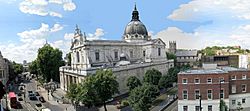London Oratory facts for kids

The Church of the Immaculate Heart of Mary is home to the London Oratory
|
|
| Monastery information | |
|---|---|
| Other names | Brompton Oratory |
| Order | Oratory of Saint Philip Neri |
| Established | 1849 |
| Dedicated to | Immaculate Heart of Mary |
| Diocese | Westminster |
| Controlled churches | Brompton Oratory |
| People | |
| Founder(s) | Fr. Frederick Faber |
| Archbishop | Vincent Nichols |
| Important associated figures | Julian Large OBE, Provost |
| Site | |
| Coordinates | 51°29′50″N 0°10′12″W / 51.49722°N 0.17000°W |
The London Oratory is a special community of Catholic priests. They follow a way of life set up by Philip Neri, a saint who lived a long time ago (1515-1595). You can find this community in an Oratory House. It is right next to the beautiful Church of the Immaculate Heart of Mary. This church is often called the Brompton Oratory. It is located on Brompton Road in London.
Did you know there are other Oratories in the UK? These include the Birmingham Oratory, the Manchester Oratory, the Oxford Oratory, and the York Oratory.
History of the London Oratory
The London Oratory started in 1849. This was just one year after Cardinal Newman began the Birmingham Oratory. Newman sent a priest named Frederick Faber and some friends to start this new community in London. Their first home was an old building in King William Street.
In 1854, the community moved to its current spot on Brompton Road. This new location is very close to the Victoria and Albert Museum. At first, Newman wasn't sure about the new place. He thought it was too far out in the suburbs back then.
Some people living nearby were not happy about a Catholic community starting there. But their efforts to stop it were not successful. An Oratory House was built in 1854. After that, a large temporary church was also built. The house had a special chapel inside called "the Little Oratory." A person named John Hungerford Pollen decorated it in 1871.
The temporary church was replaced in 1884. The new building is the grand church you see today. It was designed by Herbert Gribble. Before Westminster Cathedral opened in 1903, the London Oratory was the main place for big Catholic events in London. For example, the funeral of Cardinal Manning happened there in 1892.
People often call the community of priests and their church the 'Brompton Oratory'. This is a popular name, even if it's not the official one. The Oratory parish is part of the Westminster Catholic Diocese. The Oratory Fathers run it at the diocese's request.
About the Oratorian Fathers
The Oratorian Fathers are a group of priests. They live together as a community. They are not bound by special vows like some other religious groups. Instead, they are connected by their love for each other and their shared way of life. Their lives focus on prayer and helping people in their city.
They offer several church services every day. You can also arrange private services, weddings, and funerals. Priests are always available to hear confessions. They also offer advice and guidance. The London Oratory is known for its beautiful church services. They often use Latin and keep music as an important part of their worship. The Oratory currently has three choirs.
Leaders of the London Oratory
The Oratorian Fathers choose a leader from their group. This leader is called a provost. They serve for three years at a time. Here are some of the provosts who have led the London Oratory:
- 1969–1981: Fr Michael Scott Napier
- 1991–1994: Fr Michael Scott Napier
- ????–2012: Fr Ignatius Harrison
- 2012–present: Fr Julian Large OBE

